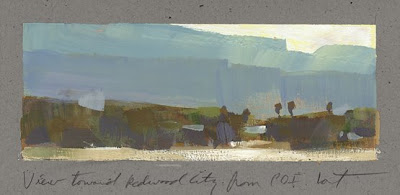
Artists always dream of creating works of permanence. Perhaps they hope that "timeless" art will help them live on past their death.
Lorado Taft (1860-1936) was that kind of artist. A Chicago sculptor of monumental, heroic subjects, Taft worked from 1907 to 1922 on his life's masterpiece, a huge sculpture about mortality called The Fountain of Time. The sculpture was based on a line from Austin Dobson:
Time goes, you say? Alas, time stays; we go!Taft created a 120 foot long parade of humanity with over 100 different figures symbolizing life's journey from birth to death.

This "march of the doomed" takes place in front of an imposing, 26 foot tall statue of Father Time.


Taft wanted his sculpture to have an eternal look, so he designed it in a classical "beaux-art" style. Unfortunately, by the time he finished, the beaux-art style was already unfashionable. It was replaced by abstract modernism. (Perhaps Time felt that Taft's ambition was impertinent and wanted to teach him a lesson.) In any event, the leading Chicago newspaper soon labeled the outdated sculpture one of the city's "pet atrocities." Resentful at the way styles had passed him by, Taft became a leading spokesperson for conservative sculpture and lectured against the evils of modernism (demonstrating that he had learned absolutely nothing about the inevitability of time).

Taft also tried to construct his sculpture using materials that would last a long time. After consulting with engineers, he decided on steel reinforced, hollow-cast concrete. Unfortunately, this choice was not well suited for Chicago winters. The concrete expanded and contracted, causing cracks in the surface. Details eroded and crumbled away forever. By the 1980s, the interior was crumbling due to moisture buildup, and the surface had become pitted and drab, assaulted by time, elements and pollution.

Even then, time was not done transforming Taft's work. Taft had envisioned his sculpture as the centerpiece of an elegant park in the style of the World's Columbian Exposition, where Taft first worked as a sculptor. However, the neighborhood changed with time. The surrounding city deteriorated even more than the sculpture. The sculpture became overgrown with weeds. There were no funds for sculpture repairs in a rough neighborhood on the south side of Chicago.

As a small boy in Chicago, I used to stand in that park and stare up at Taft's crumbling sculpture. Its subject was scary for a kid, but not nearly as scary as the changes wreaked by the passage of time.
I revisited that sculpture years later when I returned to Chicago as a law student. By then, time had transformed both me and the sculpture. I had grown to understand that, no matter how big or permanent we try to make art, it will not enable us to outwit time. No matter how grand or eternal the subject matter that we choose. No matter how wise the artist. No matter how much the artist got paid.
Taft had to learn the hard way that even art can't rescue us from the gaping maw of time; we just have to keep looking for our solace.
This happy happy love
Is sieged with crying sorrows,
Crushed beneath and above
Between todays and morrows;
A little paradise
Held in the world's vice.
....
This love a moment known
For what I do not know
And in a moment gone
Is like the happy doe
That keeps its perfect laws
Between the tiger's paws
And vindicates its cause.
. --Edwin Muir

















